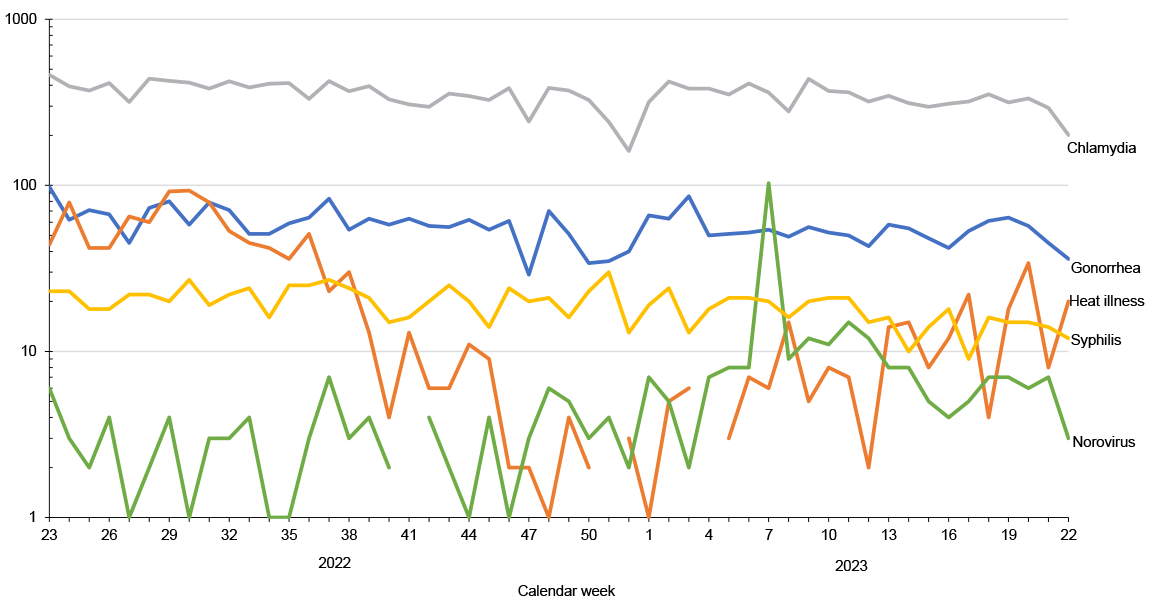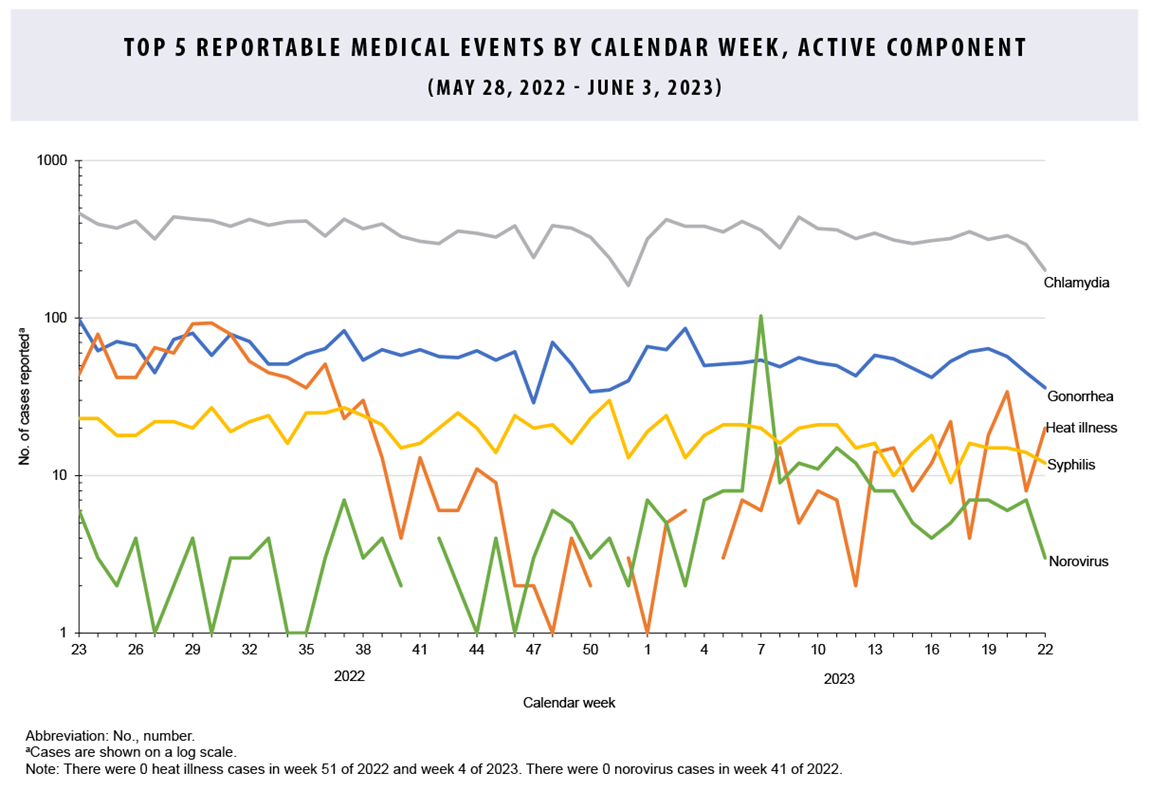Reportable Medical Events, Military Health System Facilities, Week 22, Ending June 3, 2023
 Graph depicting the frequency of the five most common reportable medical events within the Military Health System over the preceding year.
Graph depicting the frequency of the five most common reportable medical events within the Military Health System over the preceding year.
Reportable Medical Events are documented in the Disease Reporting System internet by health care providers and public health officials across the Military Health System for the purpose of monitoring, controlling, and preventing the occurrence and spread of diseases of public health interest or readiness importance. These reports are reviewed by each service’s public health surveillance hub. The DRSi collects reports on over 70 different RMEs, including infectious and non-infectious conditions, outbreak reports, STI risk surveys, and tuberculosis contact investigation reports. A complete list of RMEs is available in the 2022 Armed Forces Reportable Medical Events Guidelines and Case Definitions.1 Data reported in these tables are considered provisional and do not represent conclusive evidence until case reports are fully validated.

Total active component cases reported per week are displayed for the top five RMEs for the previous year. Each month, the graph is updated with the top five RMEs, and is presented with the current month’s (May 2023) top five RMEs, which may differ from previous months. COVID-19 is excluded from these graphs due to changes in reporting/case definition updates in 2023.

References
- Armed Forces Health Surveillance Division. Armed Forces Reportable Medical Events. Accessed April 6, 2023. https://www.health.mil/Military-Health-Topics/Health-Readiness/AFHSD/Reports-and-Publications/Armed-Forces-Reportable-Medical-Events
- Defense Manpower Data Center. Department of Defense Active Duty Military Personnel by Rank/Grade of Service, October 31, 2022. https://dwp.dmdc.osd.mil/dwp/app/dod-data-reports/workforce-reports
- Defense Manpower Data Center. Armed Forces Strength Figures for January 31, 2023. https://dwp.dmdc.osd.mil/dwp/app/dod-data-reports/workforce-reports
- Navy Medicine. Surveillance and Reporting Tools–DRSI: Disease Reporting System Internet. https://www.med.navy.mil/Navy-Marine-Corps-Public-Health-Center/Preventive-Medicine/Program-and-Policy-Support/Disease-Surveillance/DRSI
You also may be interested in...
Report
Jan 1, 2016
 .PDF |
1.58 MB
.PDF |
1.58 MB
A monthly publication of the Armed Forces Health Surveillance Branch. This issue of the peer-reviewed journal contains the following articles: Post-refractive surgery complications and eye disease, active component, U.S. Armed Forces, 2005–2014; Update: Urinary stones, active component, U.S. Armed Forces, 2011–2015; Surveillance snapshot: Zika virus ...
Report
Jan 1, 2016
 .PDF |
1.00 MB
.PDF |
1.00 MB
A monthly publication of the Armed Forces Health Surveillance Branch. This issue of the peer-reviewed journal contains the following articles: Update: Malaria, U.S. Armed Forces, 2015; Durations of service until first and recurrent episodes of clinically significant back pain, active component military members: changes among new accessions to service ...
Report
Jan 1, 2016
 .PDF |
754.38 KB
.PDF |
754.38 KB
A monthly publication of the Armed Forces Health Surveillance Branch. This issue of the peer-reviewed journal contains the following articles: Incident diagnoses of non-melanoma skin cancer, active component, U.S. Armed Forces, 2005–2014; Zika virus infections in Military Health System beneficiaries since the introduction of the virus in the Western ...
Report
Jan 1, 2016
 .PDF |
811.49 KB
.PDF |
811.49 KB
A monthly publication of the Armed Forces Health Surveillance Branch. This issue of the peer-reviewed journal contains the following articles: Incidence of abdominal hernias in service members, active component, U.S. Armed Forces, 2005–2014; Incidence of hiatal hernia in service members, active component, U.S. Armed Forces, 2005–2014.
Report
Jan 1, 2016
 .PDF |
944.80 KB
.PDF |
944.80 KB
A monthly publication of the Armed Forces Health Surveillance Branch. This issue of the peer-reviewed journal contains the following articles: Excessive vomiting in pregnancy, active component service women, U.S. Armed Forces, 2005–2014; Importance of external cause coding for injury surveillance: lessons from assessment of overexertion injuries ...
Report
Jan 1, 2016
 .PDF |
1.34 MB
.PDF |
1.34 MB
A monthly publication of the Armed Forces Health Surveillance Branch. This issue of the peer-reviewed journal contains the following articles: Update: Routine screening for antibodies to human immunodeficiency virus, civilian applicants for U.S. military service and U.S. Armed Forces, active and reserve components, January 2011–June 2016; Update: ...
Report
Jan 1, 2016
 .PDF |
1.56 MB
.PDF |
1.56 MB
A monthly publication of the Armed Forces Health Surveillance Branch. This issue of the peer-reviewed journal contains the following articles: The DoD Global, Laboratory-based, Influenza Surveillance Program: summary for the 2013-2014 influenza season; Correlation between antimicrobial resistance in Escherichia coli infections in hospitalized ...
Report
Jan 1, 2016
 .PDF |
1.56 MB
.PDF |
1.56 MB
A monthly publication of the Armed Forces Health Surveillance Branch. This issue of the peer-reviewed journal contains the following articles: Absolute and relative morbidity burdens attributable to various illnesses and injuries, active component, U.S. Armed Forces, 2015; Hospitalizations among members of the active component, U.S. Armed Forces, ...
Report
Jan 1, 2016
 .PDF |
1.42 MB
.PDF |
1.42 MB
A monthly publication of the Armed Forces Health Surveillance Branch. This issue of the peer-reviewed journal contains the following articles: Editorial: What's old is new again: syphilis in the U.S. Army; Use of quadrivalent human papillomavirus vaccine and the prevalence of antibodies to vaccine-targeted strains among female service members before ...
Report
Jan 1, 2016
 .PDF |
1.51 MB
.PDF |
1.51 MB
A monthly publication of the Armed Forces Health Surveillance Branch. This issue of the peer-reviewed journal contains the following articles: Obstructive sleep apnea and associated attrition, active component, U.S. Armed Forces, January 2004–May 2016; Update: Cold weather injuries, active and reserve components, U.S. Armed Forces, July 2011–June ...
Report
Dec 15, 2015
 .PDF |
23.24 MB
.PDF |
23.24 MB
In this annual report, you will see that the Armed Forces Health Surveillance Center continued to make significant strides in supporting public health surveillance for the Department of Defense to maintain the health and readiness of its forces, and contribute to the global health security of its allies.
Report
May 8, 2015
 .PDF |
29.62 KB
.PDF |
29.62 KB
Edgewood Arsenal has been the center of chemical warfare research and development since 1918. Therefore, it is not surprising that Edgewood Arsenal became the research hub for chemical agent testing on human subjects from 1955 through 1975. The great majority of the use of volunteers in medical (chemical) research occurred at this installation.
Report
May 8, 2015
 .PDF |
195.65 KB
.PDF |
195.65 KB
The U.S. Army established its offensive Biological Warfare program at Fort Detrick in 1943. The purpose of the program was twofold: develop defensive mechanisms against biological attack and develop weapons with which the United States could respond “in kind” if attacked by an enemy who used biological weapons.
Report
May 8, 2015
 .PDF |
107.51 KB
.PDF |
107.51 KB
Hallucinogenic agents (principally LSD) were tested on human subjects primarily at Edgewood Arsenal. The aim of this experimentation was to determine the effects of these chemicals on the nervous systems and mental functions of individuals and to evaluate preventive and therapeutic (treatment) agents to combat these effects.
Report
May 8, 2015
 .PDF |
107.26 KB
.PDF |
107.26 KB
Bari lies along the Adriatic Sea at the top of the heel of the boot of Italy (See Figure 1). During World War II, the port of Bari was under the jurisdiction of the British and was the main supply base for General Montgomery’s Eighth Army as well as the headquarters for the American Fifteenth Air Force which was activated in November 1943.
You are leaving Health.mil
The appearance of hyperlinks does not constitute endorsement by the Department of Defense of non-U.S. Government sites or the information, products, or services contained therein. Although the Defense Health Agency may or may not use these sites as additional distribution channels for Department of Defense information, it does not exercise editorial control over all of the information that you may find at these locations. Such links are provided consistent with the stated purpose of this website.
You are leaving Health.mil
View the external links disclaimer.
Last Updated: August 24, 2023